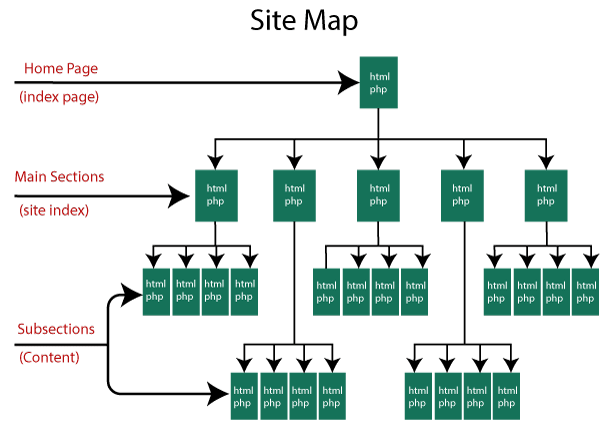
Minishortner.com What is Site Map for SEO In the ever-evolving landscape of digital marketing and search engine optimization, having the right tools and strategies in your arsenal is crucial. One such tool that plays a pivotal role in improving your website’s visibility and search engine ranking is a site map for SEO. In this comprehensive guide, we will delve into the world of site maps, focusing on “Minishortner.com: What is Site Map for SEO?”.
Minishortner.com What is Site Map for SEO

A sitemap, in the context of SEO (Search Engine Optimization), is a file or page on a website that lists and organizes all the web pages on that site. It serves as a roadmap for search engines like Google to effectively crawl and index the content of your website. There are two main types of sitemaps:
what About Minishortner
One search engine optimisation service that assists with optimising links for search engines is Minishortner SEO. Additionally, it offers user-friendly shortened URLs and sitemaps that perform well on search engine results pages.
Minishortner SEO helps businesses become more visible online and drive more traffic to their websites by optimising site links. In addition, the programme offers a number of tools like keyword research, competitor analysis, and tracking to assist companies in enhancing their search engine optimisation and maintaining an advantage over their rivals in the marketplace.
The ability to locate and resolve any technical problems with your website is another major benefit of using this gateway for site mapping.This site mapping tool makes it simple to find mistakes such as broken links, missing pages, and other issues that could lower your website’s search engine ranking. By resolving these problems, you can ensure that search engine crawlers can easily explore your website and enhance user experience on it swiftly.
How to find a sitemap for my website
To find the sitemap for your website, you can follow these steps:

- Check Your Website’s Robots.txt File:
- Visit your website and add “/robots.txt” to the end of the URL (e.g., “yourwebsite.com/robots.txt”).
- Look for a line that references the sitemap. It may appear as “Sitemap: [URL]” followed by the link to your sitemap file.
- Use a Sitemap URL:
- If you know the default location of your sitemap, you can enter the URL directly into your browser. The sitemap URL is typically in the format of “yourwebsite.com/sitemap.xml” or “yourwebsite.com/sitemap_index.xml.”
- Check Google Search Console:
- If you’ve verified your website with Google Search Console (formerly Google Webmaster Tools), you can find your sitemap in the “Sitemaps” section. Google often identifies and provides a link to your sitemap there. Minishortner.com What is Site Map for SEO
- Look in Your Content Management System (CMS):
- If you use a content management system like WordPress or Joomla, there might be plugins or settings that generate and manage sitemaps. Check the settings or options within your CMS for sitemap information.
- Manually Create a Sitemap:
- If your website doesn’t have a sitemap or you want to create a new one, you can use online sitemap generators or SEO plugins (if you use a CMS like WordPress) to generate a sitemap. Once generated, you can upload it to your website’s root directory.Minishortner.com What is Site Map for SEO
- View the Page Source:
- You can view your website’s page source by right-clicking on the webpage and selecting “View Page Source” (the wording may vary depending on your browser). Then, use the browser’s search function (usually Ctrl+F or Command+F) to search for “sitemap.” This may lead you to the sitemap URL.
- Ask Your Web Developer or Administrator:
- If you’re unsure and have someone responsible for the technical aspects of your website, ask your web developer or administrator for the location of your sitemap.
Remember that the location and format of a sitemap can vary depending on the website’s setup and the platform it’s built on. Once you find your sitemap, you can submit it to search engines like Google through their respective webmaster tools to help improve your website’s search engine visibility.
Also Read: skin care in hindi wellhealthorganic
Why Does It Matter of Minishortner.com What is Site Map for SEO
Minishortner.com What is Site Map for SEO A site map for SEO is your digital compass in the vast sea of the internet. Here’s why it matters:
- Optimized Crawling: Search engine bots rely on site maps to discover and index your web pages efficiently.
- Better Indexing: It ensures that all your web pages, including the newest ones, are included in search engine databases.
- Improved Ranking: When search engines can easily find and understand your content, it can lead to higher rankings in search results.
- Enhanced User Experience: A well-structured site map not only helps search engines but also benefits your website’s visitors.
Understanding the Basics
Before we dive deeper into the impact of site maps on SEO, let’s clarify the fundamentals. Site maps, in essence, are like maps for search engines. They provide a structured layout of your website’s content, making it easier for search engine crawlers to navigate and index your pages effectively.
How to use sitemap
Using a sitemap for your website can have several benefits, both for search engine optimization (SEO) and for providing a better user experience. Here’s how to use a sitemap effectively:
- Create a Sitemap:
- If you don’t already have a sitemap for your website, you can create one using various tools and plugins, depending on your content management system (CMS) or website platform. Alternatively, you can manually generate an XML sitemap.
- Submit to Search Engines:
- Once you have a sitemap, you should submit it to major search engines like Google, Bing, and Yahoo. You can do this through their webmaster tools or search console platforms. This helps search engines discover and index your web pages more efficiently.
- Regularly Update Your Sitemap:
- Keep your sitemap up to date. Whenever you add new content, remove old pages, or make significant changes to your website’s structure, update the sitemap accordingly.
- Improve SEO:
- Sitemaps help search engines understand your site’s structure and the relationships between various pages. This can lead to better indexing and potentially higher search engine rankings. Make sure each URL in your sitemap is accompanied by relevant metadata and keyword optimization.
- Facilitate Navigation:
- An HTML sitemap can be placed on your website to provide users with a clear and organized way to navigate your site. It’s a user-friendly directory that makes it easy for visitors to find specific content.
- Enhance User Experience:
- Having an organized sitemap can improve the overall user experience on your website. Visitors can quickly find the information they’re looking for, reducing frustration and increasing engagement.
- Debugging and Monitoring:
- Your sitemap can help you identify and fix issues with your website, such as broken links or missing pages. Regularly monitor your sitemap for errors or issues.
- Mobile Friendliness:
- Ensure that your sitemap is mobile-friendly, as many users access websites via mobile devices. A responsive design for your HTML sitemap can enhance the experience for mobile users.
- Use Images and Media:
- If your website includes images or media files, you can include them in your sitemap. This helps search engines index multimedia content more effectively.
- Prioritize Important Pages:
- You can use priority settings in your XML sitemap to tell search engines which pages are most important. This can be helpful if you have content of varying importance.
- Comply with Guidelines:
- Follow search engine guidelines when creating and updating your sitemap. Each search engine may have specific recommendations for Minishortner.com What is Site Map for SEO formatting and content.
- Track and Analyze:
- Use web analytics tools to track user behavior and interaction with your sitemap. This data can help you make informed decisions to improve your website’s performance. Minishortner.com What is Site Map for SEO
By using a sitemap effectively, you can not only improve your website’s search engine visibility but also provide a more organized and user-friendly experience for your visitors.
The Types of Site Maps Minishortner.com What is Site Map for SEO
When it comes to site maps, there are primarily two types: XML sitemaps and HTML sitemaps.
XML Sitemaps
XML sitemaps are designed for search engines. They provide essential information about your website’s pages, such as when they were last updated, the frequency of changes, and the priority of each page.
HTML Sitemaps
HTML sitemaps are created for human users. These are user-friendly, visual representations of your site’s structure, helping visitors find what they’re looking for quickly.
The Connection Between Site Maps and SEO
Now, let’s explore the intricate relationship between site maps and SEO.
Search engines, like Google, use complex algorithms to determine the relevance and quality of a website’s content. Site maps assist these algorithms in their quest for information.
Key Points to Note
- Indexing Efficiency: Search engine crawlers can easily access and understand your content, leading to better indexing.
- Keyword Optimization: You can include relevant keywords in your site map, further boosting your SEO efforts.
- Crawl Prioritization: You can indicate which pages are more important, guiding search engines to focus on them.
- Error Identification: Site maps can reveal broken links and errors, allowing you to rectify them promptly.
- Fresh Content: XML site maps inform search engines when you’ve updated content, ensuring your latest posts are indexed swiftly.
Creating an Effective Site Map
Minishortner.com What is Site Map for SEO Building an effective site map for SEO isn’t rocket science. Here’s a step-by-step guide to help you get started:
- Categorize Your Content: Group your content into logical categories or sections, making it easier to organize.
- Choose the Right Format: Decide whether you need an XML or HTML site map, or even both.
- Use Online Tools: Various online tools and plugins can generate site maps for you.
- Regular Updates: Keep your site map up to date, especially when you add new content.
- Submit to Search Engines: Once your site map is ready, submit it to search engines like Google via Google Search Console.
FAQ’s of Minishortner.com What is Site Map for SEO
Q: Why is an XML site map essential for SEO?
A: An XML site map provides vital information to search engines, helping them crawl and index your website efficiently.
Q: Can a site map improve my website’s ranking?
A: Yes, by enhancing indexing and crawl efficiency, a site map can positively impact your website’s search engine ranking.
Q: Are there free tools to generate site maps?
A: Yes, many free online tools and plugins are available to generate site maps, making it accessible for everyone.
Q: How often should I update my site map?
A: It’s best to update your site map whenever you make significant changes or add new content to your website.
Q: Do HTML site maps benefit SEO?
A: While HTML site maps are primarily for user navigation, they indirectly benefit SEO by improving the user experience.
Q: Is it necessary to submit my site map to search engines?
A: While search engines can discover your site map without submission, it’s a good practice to submit it via Google Search Console for faster indexing. Minishortner.com What is Site Map for SEO
Conclusion
Minishortner.com What is Site Map for SEO In the realm of SEO, the role of a site map cannot be overstated. It’s your secret weapon to guide search engines, improve your website’s indexing, and ultimately boost your search rankings.
Minishortner.com What is Site Map for SEO By now, you’ve gained valuable insights into what a site map for SEO is, its types, and how it impacts your website’s search engine optimization. Remember that creating and maintaining an efficient site map is an ongoing process, but the benefits it offers are well worth the effort.
So, if you’re serious about improving your website’s SEO performance, start by optimizing your site map. It’s a small step that can lead to significant results.







